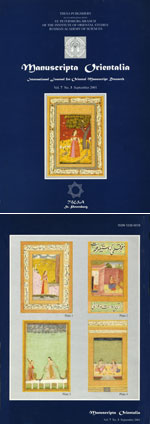|
|
| |

|

|
Vorobyova-Desyatovskaya M. A Sanskrit Manuscript on Birch-Bark from Bairam-Ali. II. Avadāna and Jātaka (Part 4) // Manuscripta Orientalia. Vol. 7, No 3, September 2001. P. 9-14.
This section of the manuscript primarily contains tales about female Buddhists. We know of the formation of the Buddhist female community and women’s monasteries since the end of the first centuries A.D., although Buddhist tradition links this fact with permission granted by the Buddha after many requests by Mahāprajāpatī Gautamī (the Buddha Sakyamuni’s aunt, who raised him after his mother’s death) and support from Ānanda. This tale has been preserved in the Pāli canon, in the Manoratha Pūranī, Anguttara-nikaya, I, 14, 5. The Pāli canon also contains a special section entitled Thertī Gāthā, which praises those women who went along with the Buddha and gained fame as his followers. The biographies of these women were described in the European literature in 1893 by M. Bode. Nonetheless, the important question of what later befell these women remains unanswered in the Pâli canon, as it does in the entire Theravāda school, which bring their heroines only to the state of arhat. Only the Mahāyāna gave a detailed answer to the question.
Since the Bairam-Ali manuscript appears to present the story of Buddhism’s first female adherents with the addition of several new details that reflect the influence of the Mahāyāna, we cite two passages from the Saddharmapundarīka-sutra in which the Buddha foretells their eternal fate: “At that time the Buddha’s maternal aunt, the nun Mahāprajāpatī, and the six thousand nuns who accompanied her, some still learning, others with nothing more to learn, rose from their seats, pressed their palms together with a single mind and gazed up at the face of the Honoured One, their eyes never leaving for an instant”. The Buddha understood the unspoken question and answered it, dedicating a prophecy to this group of his adherents: “Now if you would like to know the prophecy for you, I will say that in ages to come, amid the Law of sixty-eight thousands of millions of Buddhas, you will be a great teacher of the Law, and the six thousand nuns, some still learning, some already sufficiently learned, will accompany you as teachers of the Law”. After this, the Buddha made the same prophecy in relation to the Buddha’s wife and the mother of his son, as well as the nuns who accompanied her. Thus, the fate of these women in the future led not only to the status of boddhisattvas, but also teachers who spread the dharma.
In the Bairam-Ali manuscript, the tale of the first of these women begins on fol. 14b(4). The daughter of the head of the merchants leaves her parents’ house…
 PDF-files PDF-files
The entire paper
Keywords
Avadānas
jātakas
Manuscripta Orientalia, selected papers
Sanskrit manuscripts
|
|
|
|
Random news: Announcements |
|
On November 21‒23, 2024, the 2nd All-Russia conference of young orientalists “Army and military traditions of the Near East” will be held at the IOM RAS and the HSE (Saint Petersburg). The conference program is now available. |
|
Read more...
|
|
|
|
|

